Canon T1i vs XT
The Canon EOS Rebel T1i (called Canon 500D in some regions) and the Canon EOS Rebel XT (labelled Canon 350D in some countries) are two digital cameras that were officially introduced, respectively, in March 2009 and February 2005. Both are DSLR (Digital Single Lens Reflex) cameras that are equipped with an APS-C sensor. The T1i has a resolution of 15.1 megapixels, whereas the XT provides 8 MP.
As their names suggest, both the Canon EOS Rebel T1i and the Canon EOS Rebel XT belong to Canon's Rebel line of DSLR cameras. This range of APS-C cameras, which started out with the Canon EOS Digital Rebel in 2003, has been a big commercial success and the backbone of Canon's dominance in the digital camera market. The popularity of the Rebel cameras is the result of them inheriting much of the sensor and shooting technology from earlier released professional DSLRs, while being sold at a much more budget-friendly price point. The strong brand reputation of Canon and the comprehensive EOS system of compatible lenses and accessories further contributes to the appeal of the Rebel cams, including the Canon T1i and Canon XT. Below is an overview of the main specs of the two cameras as a starting point for the comparison.

Check T1i offers at
ebay.com

Check XT offers at
ebay.com
Going beyond this snapshot of core features and characteristics, what are the differences between the Canon EOS Rebel T1i and the Canon EOS Rebel XT? Which one should you buy? Read on to find out how these two cameras compare with respect to their body size, their imaging sensors, their shooting features, their input-output connections, and their reception by expert reviewers.
Body comparison
The side-by-side display below illustrates the physical size and weight of the Canon T1i and the Canon XT. The two cameras are presented according to their relative size. Three consecutive perspectives from the front, the top, and the back are available. All size dimensions are rounded to the nearest millimeter.
The XT can be obtained in two different colors (black, silver), while the T1i is only available in black.
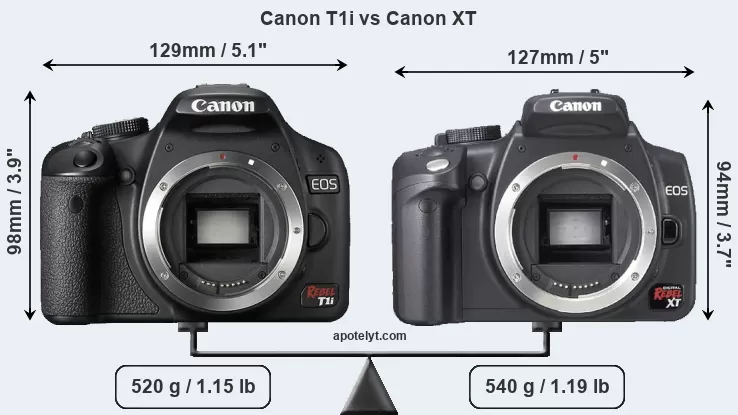
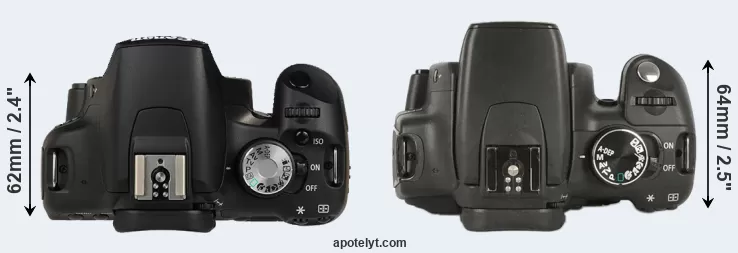
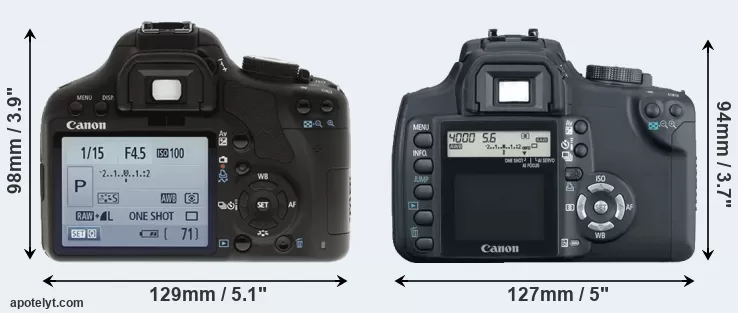
If the front view area (width x height) of the cameras is taken as an aggregate measure of their size, the Canon XT is notably smaller (6 percent) than the Canon T1i. However, the XT is slightly heavier (4 percent) than the T1i. In this context, it is worth noting that neither the T1i nor the XT are weather-sealed.
The above size and weight comparisons are to some extent incomplete since they do not consider the interchangeable lenses that both of these cameras require. In this particular case, both cameras feature the same lens mount, so that they can use the same lenses. You can compare the optics available in the Canon EF Lens Catalog.
The table below summarizes the key physical specs of the two cameras alongside a broader set of comparators. In case you want to display and compare another camera duo, you can use the CAM-parator app to select your camera combination among a large number of options.

| # | Camera Model |
Camera Width |
Camera Height |
Camera Depth |
Camera Weight |
Battery Life |
Weather Sealing |
Camera Launch |
Launch Price (USD) |
Street Price |
|
|---|---|---|---|---|---|---|---|---|---|---|---|
| 1. | Canon T1i | 129 mm | 98 mm | 62 mm | 520 g | 400 | n | Mar 2009 | 799 | ebay.com | |
| 2. | Canon XT | 127 mm | 94 mm | 64 mm | 540 g | 400 | n | Feb 2005 | 899 | ebay.com | |
| 3. | Canon T100 | 129 mm | 102 mm | 77 mm | 436 g | 500 | n | Feb 2018 | 399 | amazon.com | |
| 4. | Canon 77D | 131 mm | 100 mm | 76 mm | 540 g | 600 | n | Feb 2017 | 899 | ebay.com | |
| 5. | Canon T6 | 129 mm | 101 mm | 78 mm | 485 g | 500 | n | Mar 2016 | 449 | ebay.com | |
| 6. | Canon T6i | 132 mm | 101 mm | 78 mm | 555 g | 440 | n | Feb 2015 | 749 | ebay.com | |
| 7. | Canon T6s | 132 mm | 101 mm | 78 mm | 565 g | 440 | n | Feb 2015 | 649 | ebay.com | |
| 8. | Canon T5 | 130 mm | 100 mm | 78 mm | 480 g | 500 | n | Feb 2014 | 449 | ebay.com | |
| 9. | Canon T4i | 133 mm | 100 mm | 79 mm | 575 g | 440 | n | Jun 2012 | 849 | ebay.com | |
| 10. | Canon T3i | 133 mm | 100 mm | 80 mm | 570 g | 440 | n | Feb 2011 | 599 | ebay.com | |
| 11. | Canon T2i | 129 mm | 98 mm | 62 mm | 530 g | 440 | n | Feb 2010 | 699 | ebay.com | |
| 12. | Canon XSi | 129 mm | 98 mm | 62 mm | 524 g | 500 | n | Jan 2008 | 799 | ebay.com | |
| 13. | Canon XTi | 127 mm | 84 mm | 65 mm | 556 g | 370 | n | Aug 2006 | 799 | ebay.com | |
| 14. | Canon Rebel | 142 mm | 99 mm | 72 mm | 649 g | 400 | n | Aug 2003 | 899 | ebay.com | |
| Note: Measurements and pricing do not include easily detachable parts, such as add-on or interchangeable lenses or optional viewfinders. | |||||||||||
Any camera decision will naturally be influenced heavily by the price. The manufacturer’s suggested retail prices give an idea on the placement of the camera in the maker’s lineup and the broader market. The T1i was launched at a somewhat lower price (by 11 percent) than the XT, which makes it more attractive for photographers on a tight budget. Normally, street prices remain initially close to the MSRP, but after a couple of months, the first discounts appear. Later in the product cycle and, in particular, when the replacement model is about to appear, further discounting and stock clearance sales often push the camera price considerably down. Then, after the new model is out, very good deals can frequently be found on the pre-owned market.
Sensor comparison
The size of the sensor inside a digital camera is one of the key determinants of image quality. All other things equal, a large sensor will have larger individual pixel-units that offer better low-light sensitivity, wider dynamic range, and richer color-depth than smaller pixels in a sensor of the same technological generation. Moreover, a large sensor camera will give the photographer more control over depth-of-field in the image and, thus, the ability to better isolate a subject from the background. On the downside, larger sensors tend to be more expensive and lead to bigger and heavier cameras and lenses.
Both cameras under consideration feature an APS-C sensor, but their sensors differ slightly in size. The sensor area in the XT is 1 percent smaller. They nevertheless have the same format factor of 1.6. Both cameras have a native aspect ratio (sensor width to sensor height) of 3:2.
In terms of chip-set technology, the T1i uses a more advanced image processing engine (DIGIC 4) than the XT (DIGIC II), with benefits for noise reduction, color accuracy, and processing speed.
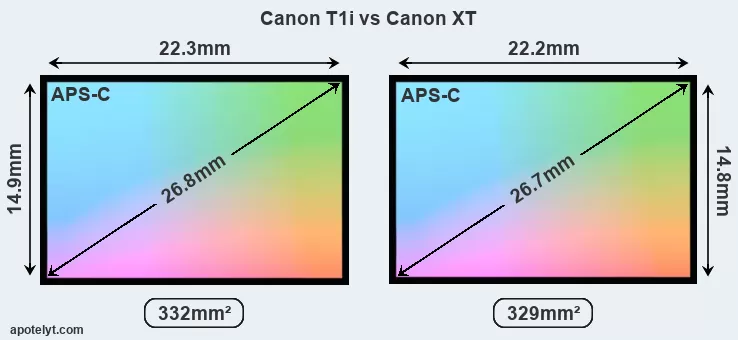
With 15.1MP, the T1i offers a higher resolution than the XT (8MP), but the T1i has smaller individual pixels (pixel pitch of 4.69μm versus 6.41μm for the XT). However, the T1i is a much more recent model (by 4 years and 1 month) than the XT, and its sensor will have benefitted from technological advances during this time that enhance the light gathering capacity of its pixels.
The resolution advantage of the Canon T1i implies greater flexibility for cropping images or the possibility to print larger pictures. The maximum print size of the T1i for good quality output (200 dots per inch) amounts to 23.8 x 15.8 inches or 60.4 x 40.2 cm, for very good quality (250 dpi) 19 x 12.7 inches or 48.3 x 32.2 cm, and for excellent quality (300 dpi) 15.8 x 10.6 inches or 40.2 x 26.8 cm. The corresponding values for the Canon XT are 17.3 x 11.5 inches or 43.9 x 29.3 cm for good quality, 13.8 x 9.2 inches or 35.1 x 23.4 cm for very good quality, and 11.5 x 7.7 inches or 29.3 x 19.5 cm for excellent quality prints.
The Canon EOS Rebel T1i has a native sensitivity range from ISO 100 to ISO 6400, which can be extended to ISO 100-12800. The corresponding ISO settings for the Canon EOS Rebel XT are ISO 100 to ISO 1600 (no boost).
Technology-wise, both cameras are equipped with CMOS (Complementary Metal–Oxide–Semiconductor) sensors. Both cameras use a Bayer filter for capturing RGB colors on a square grid of photosensors. This arrangement is found in most digital cameras.
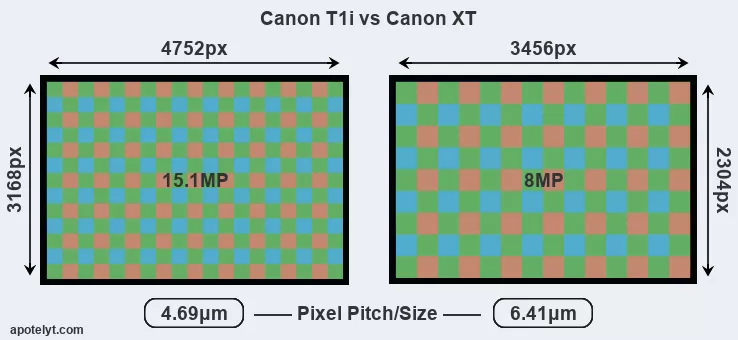
Since 2007, DXO Mark has published sensor performance measurements that have been derived using a consistent methodology. This service assesses and scores the color depth ("DXO Portrait"), dynamic range ("DXO Landscape"), and low-light sensitivity ("DXO Sports") of camera sensors, and also publishes an overall camera score. The Overall DXO ratings for the two cameras under consideration are close, suggesting that they provide similar imaging performance. The table below summarizes the physical sensor characteristics and sensor quality findings and compares them across a set of similar cameras.

| # | Camera Model |
Sensor Class |
Resolution (MP) |
Horiz. Pixels |
Vert. Pixels |
Video Format |
DXO Portrait |
DXO Landscape |
DXO Sports |
DXO Overall |
|
|---|---|---|---|---|---|---|---|---|---|---|---|
| 1. | Canon T1i | APS-C | 15.1 | 4752 | 3168 | 1080/20p | 21.7 | 11.5 | 663 | 63 | |
| 2. | Canon XT | APS-C | 8.0 | 3456 | 2304 | none | 21.8 | 10.8 | 637 | 60 | |
| 3. | Canon T100 | APS-C | 17.9 | 5184 | 3456 | 1080/30p | 21.9 | 11.4 | 695 | 63 | |
| 4. | Canon 77D | APS-C | 24.0 | 6000 | 4000 | 1080/60p | 23.6 | 13.3 | 971 | 78 | |
| 5. | Canon T6 | APS-C | 17.9 | 5184 | 3456 | 1080/30p | 22.0 | 11.7 | 781 | 66 | |
| 6. | Canon T6i | APS-C | 24.0 | 6000 | 4000 | 1080/30p | 22.7 | 12.0 | 919 | 71 | |
| 7. | Canon T6s | APS-C | 24.0 | 6000 | 4000 | 1080/30p | 22.6 | 12.0 | 915 | 70 | |
| 8. | Canon T5 | APS-C | 17.9 | 5184 | 3456 | 1080/30p | 21.9 | 11.3 | 724 | 63 | |
| 9. | Canon T4i | APS-C | 17.9 | 5184 | 3456 | 1080/30p | 21.7 | 11.2 | 722 | 62 | |
| 10. | Canon T3i | APS-C | 17.9 | 5184 | 3456 | 1080/30p | 22.1 | 11.5 | 793 | 65 | |
| 11. | Canon T2i | APS-C | 17.9 | 5184 | 3456 | 1080/30p | 22.1 | 11.5 | 784 | 66 | |
| 12. | Canon XSi | APS-C | 12.2 | 4272 | 2848 | none | 21.9 | 10.8 | 692 | 61 | |
| 13. | Canon XTi | APS-C | 10.1 | 3888 | 2592 | none | 22.1 | 11.0 | 664 | 62 | |
| 14. | Canon Rebel | APS-C | 6.3 | 3072 | 2048 | none | 21.0 | 10.8 | 544 | 55 |
Many modern cameras are not only capable of taking still images, but can also record movies. The T1i indeed provides movie recording capabilities, while the XT does not. The highest resolution format that the T1i can use is 1080/20p.
Feature comparison
Apart from body and sensor, cameras can and do differ across a range of features. The T1i and the XT are similar in the sense that both have an optical viewfinder. The latter is useful for getting a clear image for framing even in brightly lit environments. The viewfinders of both cameras offer the same field of view (95%), but the viewfinder of the T1i has a higher magnification than the one of the XT (0.54x vs 0.49x), so that the size of the image transmitted appears closer to the size seen with the naked human eye. The adjacent table lists some of the other core features of the Canon T1i and Canon XT along with similar information for a selection of comparators.

| # | Camera Model |
Viewfinder (Type or 000 dots) |
Control Panel (yes/no) |
LCD Specifications (inch/000 dots) |
LCD Attach- ment |
Touch Screen (yes/no) |
Max Shutter Speed * |
Max Shutter Flaps * |
Built-in Flash (yes/no) |
Built-in Image Stab |
|
|---|---|---|---|---|---|---|---|---|---|---|---|
| 1. | Canon T1i | optical | n | 3.0 / 920 | fixed | n | 1/4000s | 3.4/s | Y | n | |
| 2. | Canon XT | optical | n | 1.8 / 115 | fixed | n | 1/4000s | 3.0/s | Y | n | |
| 3. | Canon T100 | optical | n | 2.7 / 230 | fixed | n | 1/4000s | 3.0/s | Y | n | |
| 4. | Canon 77D | optical | Y | 3.0 / 1040 | swivel | Y | 1/4000s | 6.0/s | Y | n | |
| 5. | Canon T6 | optical | n | 3.0 / 920 | fixed | n | 1/4000s | 3.0/s | Y | n | |
| 6. | Canon T6i | optical | n | 3.0 / 1040 | swivel | Y | 1/4000s | 5.0/s | Y | n | |
| 7. | Canon T6s | optical | Y | 3.0 / 1040 | swivel | Y | 1/4000s | 5.0/s | Y | n | |
| 8. | Canon T5 | optical | n | 3.0 / 460 | fixed | n | 1/4000s | 3.0/s | Y | n | |
| 9. | Canon T4i | optical | n | 3.0 / 1040 | swivel | Y | 1/4000s | 5.0/s | Y | n | |
| 10. | Canon T3i | optical | n | 3.0 / 1040 | swivel | n | 1/4000s | 3.7/s | Y | n | |
| 11. | Canon T2i | optical | n | 3.0 / 1040 | fixed | n | 1/4000s | 3.7/s | Y | n | |
| 12. | Canon XSi | optical | n | 3.0 / 230 | fixed | n | 1/4000s | 3.5/s | Y | n | |
| 13. | Canon XTi | optical | n | 2.5 / 230 | fixed | n | 1/4000s | 3.0/s | Y | n | |
| 14. | Canon Rebel | optical | n | 1.8 / 118 | fixed | n | 1/4000s | 2.5/s | Y | n | |
| Note: *) Information refers to the mechanical shutter, unless the camera only has an electronic one. | |||||||||||
The T1i writes its imaging data to SDHC cards, while the XT uses Compact Flash cards.
Connectivity comparison
For some imaging applications, the extent to which a camera can communicate with its environment can be an important aspect in the camera decision process. The table below provides an overview of the connectivity of the Canon EOS Rebel T1i and Canon EOS Rebel XT and, in particular, the interfaces the cameras (and selected comparators) provide for accessory control and data transfer.

| # | Camera Model |
Hotshoe Port |
Internal Mic / Speaker |
Microphone Port |
Headphone Port |
HDMI Port |
USB Port |
WiFi Support |
NFC Support |
Bluetooth Support |
|
|---|---|---|---|---|---|---|---|---|---|---|---|
| 1. | Canon T1i | Y | mono / mono | - | - | mini | 2.0 | - | - | - | |
| 2. | Canon XT | Y | - / - | - | - | - | 2.0 | - | - | - | |
| 3. | Canon T100 | Y | mono / mono | - | - | mini | 2.0 | Y | Y | - | |
| 4. | Canon 77D | Y | stereo / mono | Y | - | mini | 2.0 | Y | Y | Y | |
| 5. | Canon T6 | Y | mono / mono | - | - | mini | 2.0 | Y | Y | - | |
| 6. | Canon T6i | Y | stereo / mono | Y | - | mini | 2.0 | Y | Y | - | |
| 7. | Canon T6s | Y | stereo / mono | Y | - | mini | 2.0 | Y | Y | - | |
| 8. | Canon T5 | Y | mono / mono | - | - | mini | 2.0 | - | - | - | |
| 9. | Canon T4i | Y | stereo / mono | Y | - | mini | 2.0 | - | - | - | |
| 10. | Canon T3i | Y | mono / mono | Y | - | mini | 2.0 | - | - | - | |
| 11. | Canon T2i | Y | stereo / - | Y | - | mini | 2.0 | - | - | - | |
| 12. | Canon XSi | Y | - / - | - | - | mini | 2.0 | - | - | - | |
| 13. | Canon XTi | Y | - / - | - | - | - | 2.0 | - | - | - | |
| 14. | Canon Rebel | Y | - / - | - | - | - | 1.1 | - | - | - |
Both the T1i and the XT have been discontinued, but can regularly be found used on ebay. The XT was replaced by the Canon Xti, while the T1i was followed by the Canon T2i. Further information on the features and operation of the T1i and XT can be found, respectively, in the Canon T1i Manual (free pdf) or the online Canon XT Manual.
Review summary
So how do things add up? Which of the two cameras – the Canon T1i or the Canon XT – has the upper hand? Is one clearly better than the other? The listing below highlights the relative strengths of the two models.
Arguments in favor of the Canon EOS Rebel T1i:
- More detail: Offers more megapixels (15.1 vs 8MP) with a 37% higher linear resolution.
- More dynamic range: Captures a larger spectrum of light and dark details (0.7 EV of extra DR).
- Better jpgs: Has a more modern image processing engine (DIGIC 4 vs DIGIC II).
- Broader imaging potential: Can record not only still images but also 1080/20p movies.
- Larger viewfinder image: Features a viewfinder with a higher magnification (0.54x vs 0.49x).
- Larger screen: Has a bigger rear LCD (3.0" vs 1.8") for image review and settings control.
- More detailed LCD: Has a higher resolution rear screen (920k vs 115k dots).
- Faster burst: Shoots at higher frequency (3.4 vs 3 flaps/sec) to capture the decisive moment.
- More affordable: Was introduced into a lower priced segment (11 percent cheaper at launch).
- More modern: Reflects 4 years and 1 month of technical progress since the XT launch.
Advantages of the Canon EOS Rebel XT:
- More heavily discounted: Has been around for much longer (launched in February 2005).
If the count of relative strengths (bullet points above) is taken as a measure, the T1i is the clear winner of the match-up (10 : 1 points). However, the relevance of individual strengths will vary across photographers, so that you might want to apply your own weighing scheme to the summary points when reflecting and deciding on a new camera. A professional wedding photographer will view the differences between cameras in a way that diverges from the perspective of a travel photog, and a person interested in cityscapes has distinct needs from a macro shooter. Hence, the decision which camera is best and worth buying is often a very personal one.
How about other alternatives? Do the specifications of the Canon T1i and the Canon XT place the cameras among the top in their class? Find out in the latest Best DSLR Camera listing whether the two cameras rank among the cream of the crop.
In any case, while the comparison of the spec-sheets of cameras can offer a general idea of their imaging potential, it remains partial and cannot reveal, for example, the shooting experience and imaging performance when actually working with the T1i or the XT. User reviews, such as those found at amazon, can sometimes inform about these issues, but such feedback is often incomplete, inconsistent, and biased.
Expert reviews
This is why expert reviews are important. The following table reports the overall ratings of the cameras as published by some of the major camera review sites (amateurphotographer [AP], cameralabs [CL], digitalcameraworld [DCW], dpreview [DPR], ephotozine [EPZ], photographyblog [PB]). As can be seen, the professional reviewers agree in many cases on the quality of different cameras, but sometimes their assessments diverge, reinforcing the earlier point that a camera decision is often a very personal choice.

| # | Camera Model |
AP score |
CL score |
DCW score |
DPR score |
EPZ score |
PB score |
Camera Launch |
Launch Price (USD) |
Street Price |
|
|---|---|---|---|---|---|---|---|---|---|---|---|
| 1. | Canon T1i | .. | + + | .. | 74/100 | 4.5/5 | 4.5/5 | Mar 2009 | 799 | ebay.com | |
| 2. | Canon XT | .. | 80/100 | .. | + + | o | .. | Feb 2005 | 899 | ebay.com | |
| 3. | Canon T100 | .. | o | 3/5 | .. | 3.5/5 | 3.5/5 | Feb 2018 | 399 | amazon.com | |
| 4. | Canon 77D | 4.5/5 | .. | 4/5 | 82/100 | 4.5/5 | 4/5 | Feb 2017 | 899 | ebay.com | |
| 5. | Canon T6 | 4/5 | o | 4/5 | 73/100 | 4/5 | 4/5 | Mar 2016 | 449 | ebay.com | |
| 6. | Canon T6i | 5/5 | .. | .. | 75/100 | 4.5/5 | 4.5/5 | Feb 2015 | 749 | ebay.com | |
| 7. | Canon T6s | 5/5 | + | .. | 77/100 | 4.5/5 | 4.5/5 | Feb 2015 | 649 | ebay.com | |
| 8. | Canon T5 | 3/5 | + | .. | .. | 4/5 | 4.5/5 | Feb 2014 | 449 | ebay.com | |
| 9. | Canon T4i | 4/5 | + + | .. | 77/100 | 4.5/5 | 4.5/5 | Jun 2012 | 849 | ebay.com | |
| 10. | Canon T3i | 3/5 | o | .. | 77/100 | 4.5/5 | 4.5/5 | Feb 2011 | 599 | ebay.com | |
| 11. | Canon T2i | .. | + + | .. | 77/100 | 4/5 | 4.5/5 | Feb 2010 | 699 | ebay.com | |
| 12. | Canon XSi | .. | + + | .. | + + | 4/5 | 4.5/5 | Jan 2008 | 799 | ebay.com | |
| 13. | Canon XTi | .. | + + | .. | + + | o | 4/5 | Aug 2006 | 799 | ebay.com | |
| 14. | Canon Rebel | .. | .. | .. | + + | .. | .. | Aug 2003 | 899 | ebay.com | |
| Note: (+ +) highly recommended; (+) recommended; (o) reviewed; (..) not available. | |||||||||||
Care should be taken when interpreting the review scores above, though. The assessments were made in relation to similar cameras of the same technological generation. Thus, a score needs to be put into the context of the launch date and the launch price of the camera, and comparing ratings of very distinct cameras or ones that are far apart in terms of their release date have little meaning. Also, please note that some of the review sites have changed their methodology and reporting over time.

Check T1i offers at
ebay.com

Check XT offers at
ebay.com
Other camera comparisons
Did this review help to inform your camera decision process? In case you would like to check on the differences and similarities of other camera models, just use the search menu below. Alternatively, you can follow any of the listed hyperlinks for comparisons that others found interesting.
Specifications: Canon T1i vs Canon XT
Below is a side-by-side comparison of the specs of the two cameras to facilitate a quick review of their differences and common features.
| Camera Model | Canon T1i | Canon XT |
|---|---|---|
| Camera Type | Digital single lens reflex | Digital single lens reflex |
| Camera Lens | Canon EF mount lenses | Canon EF mount lenses |
| Launch Date | March 2009 | February 2005 |
| Launch Price | USD 799 | USD 899 |
| Sensor Specs | Canon T1i | Canon XT |
| Sensor Technology | CMOS | CMOS |
| Sensor Format | APS-C Sensor | APS-C Sensor |
| Sensor Size | 22.3 x 14.9 mm | 22.2 x 14.8 mm |
| Sensor Area | 332.27 mm2 | 328.56 mm2 |
| Sensor Diagonal | 26.8 mm | 26.7 mm |
| Crop Factor | 1.6x | 1.6x |
| Sensor Resolution | 15.1 Megapixels | 8 Megapixels |
| Image Resolution | 4752 x 3168 pixels | 3456 x 2304 pixels |
| Pixel Pitch | 4.69 μm | 6.41 μm |
| Pixel Density | 4.53 MP/cm2 | 2.42 MP/cm2 |
| Moiré control | Anti-Alias filter | Anti-Alias filter |
| Movie Capability | 1080/20p Video | no Video |
| ISO Setting | 100 - 6,400 ISO | 100 - 1,600 ISO |
| ISO Boost | 100 - 12,800 ISO | no Enhancement |
| Image Processor | DIGIC 4 | DIGIC II |
| DXO Sensor Quality (score) | 63 | 60 |
| DXO Color Depth (bits) | 21.7 | 21.8 |
| DXO Dynamic Range (EV) | 11.5 | 10.8 |
| DXO Low Light (ISO) | 663 | 637 |
| Screen Specs | Canon T1i | Canon XT |
| Viewfinder Type | Optical viewfinder | Optical viewfinder |
| Viewfinder Field of View | 95% | 95% |
| Viewfinder Magnification | 0.54x | 0.49x |
| LCD Framing | Live View | |
| Rear LCD Size | 3.0inch | 1.8inch |
| LCD Resolution | 920k dots | 115k dots |
| LCD Attachment | Fixed screen | Fixed screen |
| Shooting Specs | Canon T1i | Canon XT |
| Focus System | Phase-detect AF | Phase-detect AF |
| Continuous Shooting | 3.4 shutter flaps/s | 3 shutter flaps/s |
| Shutter Life Expectancy | 100 000 actuations | 50 000 actuations |
| Fill Flash | Built-in Flash | Built-in Flash |
| Storage Medium | SDHC cards | CF cards |
| Single or Dual Card Slots | Single card slot | Single card slot |
| Connectivity Specs | Canon T1i | Canon XT |
| External Flash | Hotshoe | Hotshoe |
| USB Connector | USB 2.0 | USB 2.0 |
| HDMI Port | mini HDMI | no HDMI |
| Wifi Support | no Wifi | no Wifi |
| Body Specs | Canon T1i | Canon XT |
| Battery Type | Canon LP-E5 | Canon NB-2LH |
| Battery Life (CIPA) | 400 shots per charge | 400 shots per charge |
| Body Dimensions |
129 x 98 x 62 mm (5.1 x 3.9 x 2.4 in) |
127 x 94 x 64 mm (5.0 x 3.7 x 2.5 in) |
| Camera Weight | 520 g (18.3 oz) | 540 g (19.0 oz) |

Check T1i offers at
ebay.com

Check XT offers at
ebay.com
Did you notice an error on this page? If so, please get in touch, so that we can correct the information.

